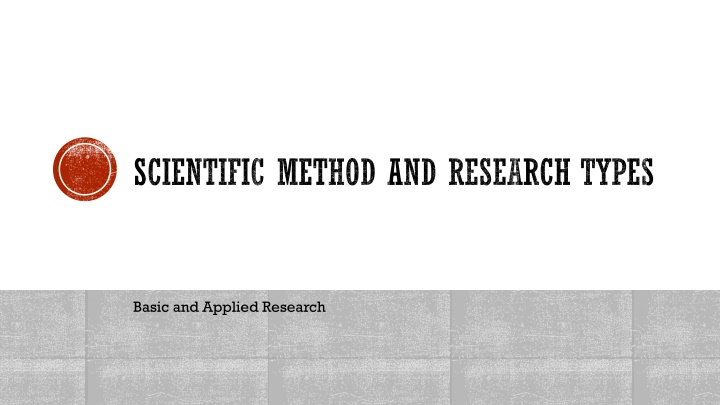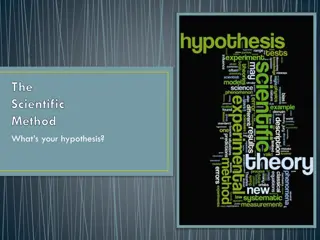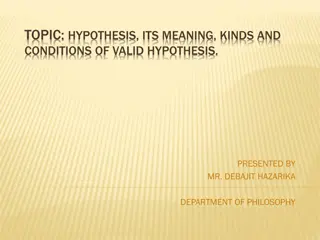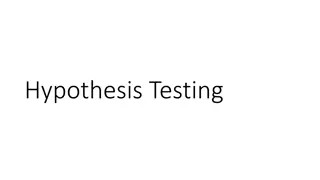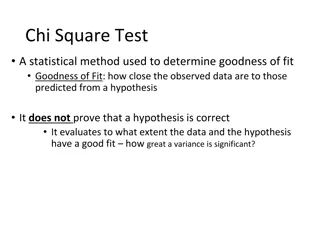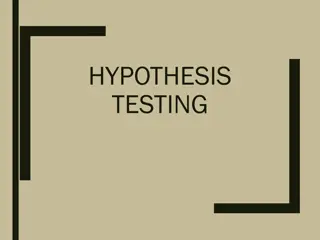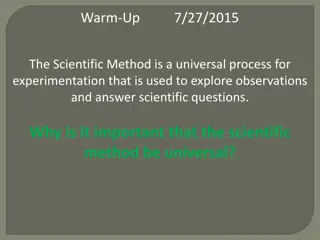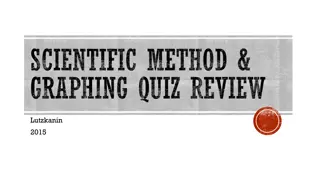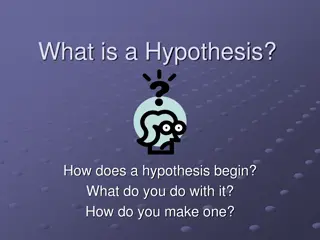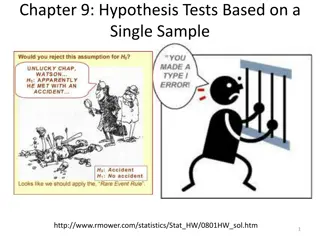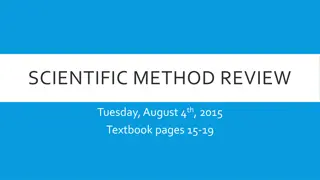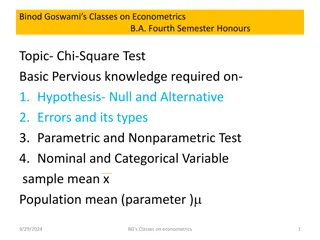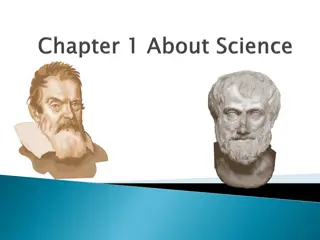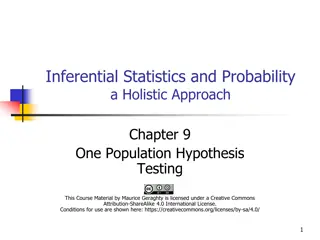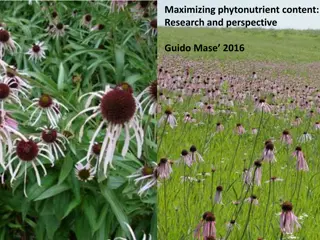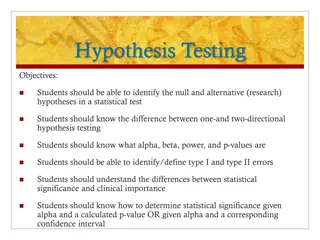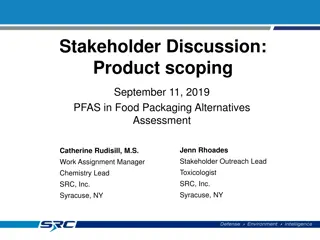Scientific Method & Research Types: Basic vs. Applied, Hypothesis Setup, Data Collection Modes
The scientific method and research types, this content covers basic and applied research, setting up hypotheses with independent and dependent variables, and modes of collecting data such as observation and case studies. It emphasizes the importance of literature review, data analysis, and interpretation of results in the context of existing knowledge.
Download Presentation

Please find below an Image/Link to download the presentation.
The content on the website is provided AS IS for your information and personal use only. It may not be sold, licensed, or shared on other websites without obtaining consent from the author.If you encounter any issues during the download, it is possible that the publisher has removed the file from their server.
You are allowed to download the files provided on this website for personal or commercial use, subject to the condition that they are used lawfully. All files are the property of their respective owners.
The content on the website is provided AS IS for your information and personal use only. It may not be sold, licensed, or shared on other websites without obtaining consent from the author.
E N D
Presentation Transcript
SCIENTIFIC METHOD AND RESEARCH TYPES Basic and Applied Research
Notes: The question asked is either basic or applied Try again NEVER with the same data set *data mining* Literature review is ESSENTIAL It s the educated piece of an educated guess Data can be analyzed in a NUMBER of ways The type of analysis MUST be determined before the research is conducted Results are to be interpreted in the context of previous literature If you are ADDING something to the existing conversation, you PUBLISH results (regardless of hypothesis correctness)
SETTING UP YOUR HYPOTHESIS Independent variable The first domino to fall Dependent variable Is related to or caused by the Independent variable If, then wording helps to identify these variables Use the term cause RARELY (only in experiments) Confounding variables (IMPORTANT TO KEEP IN MIND!) Think of the phrase above and beyond It s like preparing yourself in advance for criticism of others Example physician racism and # of doctor s visits relationship
MODES OF COLLECTING DATA Observation, Case Studies, Surveys/Interviews
OBSERVATION Observation differs from most other forms of data collection--researcher does not manipulate variables or directly question participants. The advantages of observation: observing natural behavior refining hypotheses allowing for observation of behavior that cannot be produced in an artificial environment for ethical or practical reasons. The disadvantages of observation: studies do not produce quantitative data do not allow for cause and effect statements may be very time consuming can be prone to researcher bias.
CASE STUDIES Case studies allow for the development of novel hypotheses provide detailed descriptions of rare events explore the intricacies of existing theories of causation. Case studies cannot directly indicate cause and effect relationships or test hypotheses findings from case studies cannot be generalized to a wider population. Famous case studies, like that of Phineas Gage, and researchers using case studies, like Jean Piaget, have helped establish entire fields of psychology. Phineas Gage helped researchers understand the relationship between brain areas and personality Piaget developed a model of development based on his studies.
SURVEYS AND INTERVIEWS The survey method of data collection is likely the most common of the research methods. The benefits of this method include low cost, large sample size, and efficiency. The major problem with this method is accuracy: since surveys depend on subjects' motivation, honesty, memory, and ability to respond, they are very susceptible to bias. You CAN and MUST combat bias in a number of ways Power analysis Language Incentive Transparency Sampling methods A researcher must have a strong understanding of how to properly frame survey questions in order to gather reliable and relevant information. Psychological measurement is its own discipline--- reliable measures are certain Reliability AND validity
TYPES OF RESEARCH Descriptive, Correlational, Experimental
DESCRIPTIVE RESEARCH Descriptive studies do not test specific relationships between factors they provide information about behaviors and attributes with the goal of reaching a better understanding of a given topic. Descriptive research is a useful method of gathering information about rare phenomena that could not be reproduced in a laboratory or about subjects that are not well understood. Descriptive research is an example of basic research
CORRELATIONAL Defined as: the extent to which 2 or more things differ similarly There are some instances where experimental research is not an option for practical or ethical reasons. correlational research is used to determine if two (or more) variables are related. Correlations can be used to make predictions about the likelihood of two (or more) variables occurring together. Correlation does not imply causation. Just because one factor correlates with another does not mean the first factor causes the other or that these are the only two factors involved in the relationship. Remember, confounding variables and directionality Only an experiment can establish cause and effect. Correlations can be POWERFUL despite being able to prove cause and effect--- correlations can also be meaningless. It s a balancing act!
EXPERIMENTAL RESEARCH Experiments are generally the most precise studies and have the most conclusive power. They are particularly effective in supporting hypotheses about cause and effect relationships. However, since the conditions in an experiment are somewhat artificial, they may not apply to everyday situations. A well-designed experiment has features that control random variables to make sure that the effect measured is caused by the independent variable being manipulated. These features include random assignment, use of a control group, and use of a single or double-blind design. SAMPLING is CRUCIAL to experimentation An experimenter decides how to manipulate the independent variable while measuring the dependent variable. In a good experiment, only the independent variable will affect the dependent variable. Confounding variables (other Independent variables) ideally get ruled out OR their effects are reduce by the manipulated IV
BROADLY DEFINED TYPES OF RESEARCH Qualitative Quantitative Mixed-methods Meta-analysis Literature Review
ETHICAL GUIDELINES (HUMAN RESEARCH) Ethical guidelines that govern the use of human subjects in research are a fairly new but important construct developed in response to unethical and harmful experiments such as the Tuskegee syphilis experiment. As a result of various unethical experiments carried out in the United States in the 20th century, several organizations were put in place to help monitor clinical research involving humans. At most colleges and universities, institutional review boards (ethics committees) are formally chosen to approve, review, and monitor bio-medical and behavioral research involving humans. Key ethical guidelines include the assurance of confidentiality, informed consent, and debriefing.
